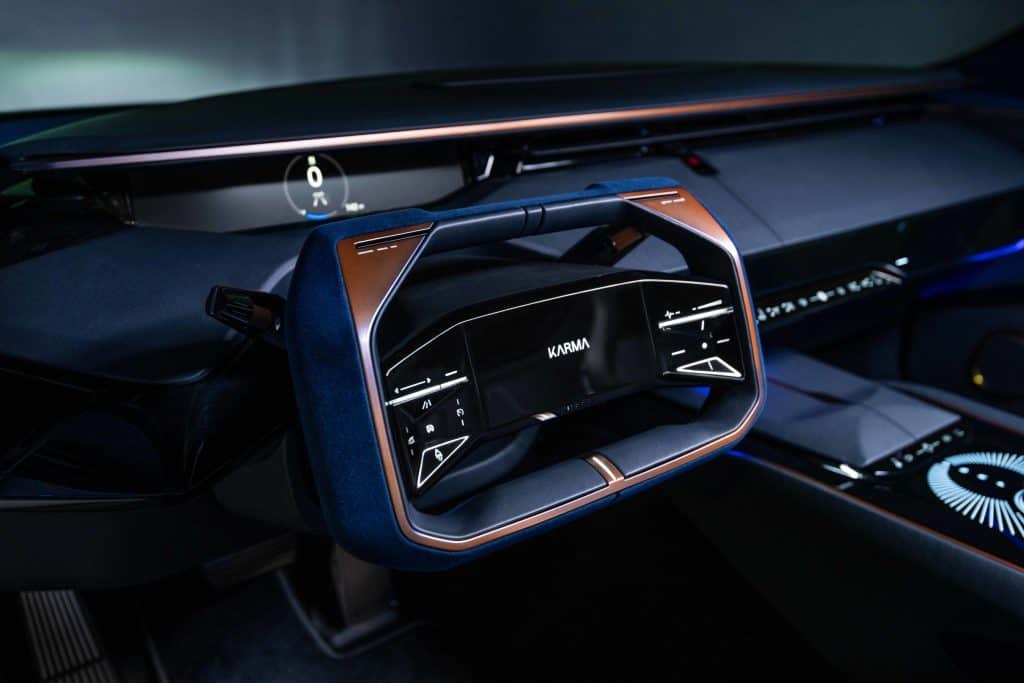
Karma Automotive, California’s first and only ultra luxury automaker, today announces its bilateral collaboration with Intel Automotive to co-develop Software Defined Vehicle Architecture (SDVA) which will underpin its upcoming vehicles including the Karma Kaveya super coupe, anticipated to arrive in 2026. Further, through the shared expertise from their respective industries, the companies will demonstrate and validate critical concepts for the advancement of open standards for SDVA that can be shared openly and commercially to support the transformation of the broader automotive industry.
“Karma Automotive, together with Intel Automotive, will realize SDVA’s full potential to create innovative, intelligent and beautiful Karma automobiles which, in addition to delivering unparalleled driving dynamics, will be highly efficient and offer an exceptional ownership experience,” says Marques McCammon, President, Karma Automotive. “For Tier 1’s and OEMs (Original Equipment Manufacturers) not quite ready to take the leap from the old way of doing things to the new, Karma Automotive will play as an ally, helping them make that transition with business-to-business SDVA solutions in the same way we do today with Karma Connect, our proprietary Vehicle Data Management and Over the Air services platform, which presently provides services to the world’s second largest OEM.”
“As the leader of Intel Automotive, I come by my love of cars honestly, my family having owned everything from a Renault Le Car to a Porsche and an MBG. At Intel Automotive we can see that the industry is facing a perfect storm of unprecedented change. Intel has assisted other industries with such transformations in the past and we’re honored to do the same in Automotive,” says Jack Weast, Intel Fellow, Vice President, General Manager, Intel Automotive. “Together, through this collaboration with Karma Automotive, we’re in a position to prepare the industry for the leap forward to SDVA without leaving anyone behind.”
McCammon and Weast first aligned on the vision for the future of the automobile during their work as colleagues over a decade ago at Wind River, formerly a division of Intel.
The Karma Kaveya super coupe, with up to 1,000 horsepower, optional all-wheel drive and a sub-three second 0-60, will be priced from approximately $300,000 USD when it arrives in 2026, and is anticipated to be the world’s first vehicle developed from the ground-up with true SDVA. All future Karma automobiles to follow the Kaveya, including the potential production version of Karma Automotive’s “GT-UV” Design Study which makes its Global Premiere at The Quail, A Motorsports Gathering, on Friday, August 16 in Monterey, CA, will follow this same path, utilizing SDVA co-developed with Intel Automotive.
Software Defined Vehicle Architecture (SDVA): Technical Explanation & Background
Since the invention of the automobile in 1888, its architecture has remained relatively unchanged: powertrains have become more powerful and efficient, and vehicle safety has greatly improved, but the format has stayed largely the same. With the addition of each new feature from fuel injection and power windows to air-conditioning and Advanced Driver Assistance Systems (ADAS), today’s vehicle typically has over 100 Electric Control Units (ECUs), each delivering a single function, requiring over a mile of copper cabling to connect. Layer upon layer has been piled atop a foundation which can no longer support the future of the automobile. The solution can be found in the Information Technology (IT) industry, which long ago moved away from single function devices to high-performance computing systems where multiple workloads run on a single, centralized system. Similarly, SDVA looks at the vehicle systems as a whole, and allows for the seamless movement of workloads between software-defined central “compute” systems and software-defined zonal “compute” sub-systems, ensuring maximum flexibility, optimal cost and performance with significant energy efficiency benefits.
As an example, many EVs – even when switched “off” – support a feature that still monitors the external cameras for security threats or to recognize the driver as they approach. Typically, this feature is supported on the vehicle’s in-cabin “compute” subsystem, which due to its high-power consumption, puts unnecessary drain on the battery even when the vehicle is off. This workload doesn’t have to stay resident on the software-defined central “compute” system. Using Intel’s software-defined zonal controllers to handle camera streams, data center application orchestration concepts can be embraced and migrate the workload to a lower-power device (in this case the zonal controller) and wake the central compute system only when needed. It would save energy, improve efficiency and reduce the total number of electronic control units (ECUs) in the vehicle by consolidating workloads dynamically onto a software-defined zonal controller.